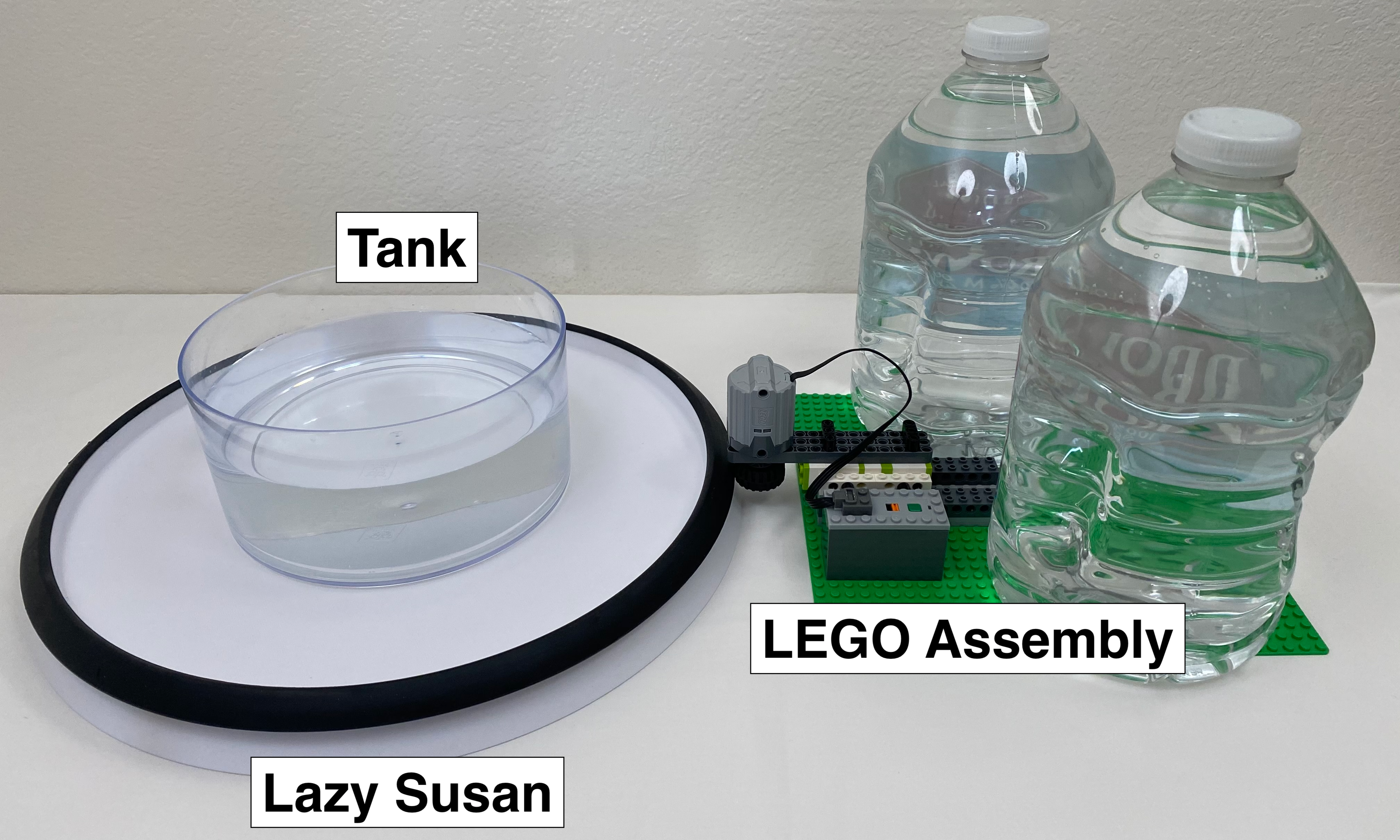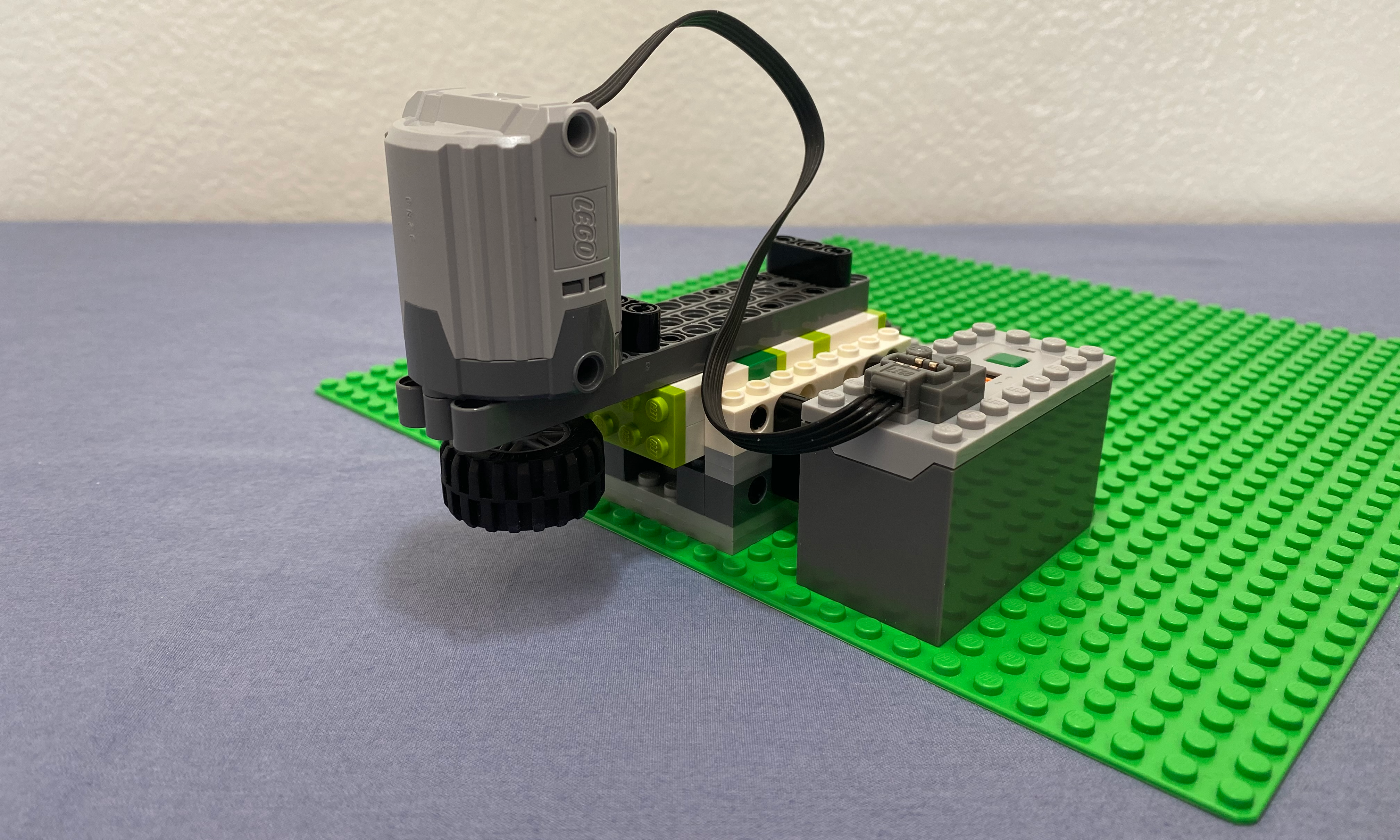NOTICE — we have a wonderful new design of the LEGO‑based table! We are in the slow process of overhauling this website, including hosting the instructions and other materials for this new kit. In the meantime, please consult the resources below.
- Instructions YouTube video: watch here
- Instructions PDF: Google Drive link
- Parts list: Google Sheet
- STL files for motor adapter: download
- Contact: Jon Aurnou — jona@epss.ucla.edu • profile
Experimenting with your own LEGO-Based Table is fun and easy!
Already have your table assembled and working? Head over to the Teaching page to learn how to incorporate it into the classroom. Otherwise, this page provides everything you need to know to order, build and operate one yourself.
What are the LEGO-Based Tables?

The LEGO-Based Tables are robust and affordable platforms for you to perform rotating tank experiments yourself!
The LEGO-Based Tables are rotating tank platforms created using LEGOs and other household items for $80 or less. The tables provide a robust and affordable solution for performing rotating tank experiments that model geophysical fluid dynamics!
The tables are composed of the 1) LEGO assembly, 2) OXO kitchen turntable and 3) clear cylindrical tank. The tank is placed at the center of the turntable and filled with water. The LEGO assembly supports a horizontal drive wheel that contacts and rotates the turntable via a battery powered LEGO Power Functions motor.
The LEGO-Based Tables consist of 2 variants, the LEGO Table and the Technics Table, characterized by their LEGO assembly designs.

The LEGO Table features a minimalist LEGO assembly.
Developed in 2017, the first generation LEGO Table can be purchased in its entirety (LEGO assembly, turntable and tank) for $55. The LEGO Table was developed to fulfill our goals of providing a rotating tank platform accessible to as many classrooms as possible. Its LEGO assembly is composed of LEGO pieces to create a minimalist design.

The Technics Table features a fortified LEGO assembly.
Developed in 2020, the second generation Technics Table can be purchased in its entirety (LEGO assembly, turntable and tank) for $80. The Technics Table was developed incorporating feedback from the DIYnamics community’s experiences with the LEGO Table. Its LEGO assembly utilizes Technics, a variety of LEGO, pieces to maintain stronger connections and a larger baseplate to improve stability. These improvements result in a design that is more complex but much more permanent than its predecessor.
Both the LEGO Table and Technics Table enable you to perform rotating tank experiments modeling fluid dynamics! Choose either design to perform your experiments. The LEGO Table remains a great option as our most inexpensive and easiest to build platform. However, especially for repeated or prolonged demonstrations, we’ve learned from users all over the world that it can sometimes be inconsistent. The Technics Table has greater upfront costs but its much improved rigidity results in a better overall experience — the platform is more stable and less prone to losing contact or breaking during demonstrations. The DIYnamics community has developed add-ons that increase the functionality of both designs for stunning results!
How to Order and Build the LEGO Table
Here we describe the steps to buying components for and assembling the LEGO Table.
Parts List PDF
This PDF lists the parts necessary for the required features of the LEGO Table. All of the parts needed are available for purchase online from Amazon and the LEGO website.
Instructions PDF
This PDF provides an illustrated step-by-step guide to assembling the LEGO Table.
How to Order and Build the Technics Table
Here we describe the steps to buying components for and assembling the Technics Table.
Parts List
This PDF lists the parts necessary for the required as well as optional (described below) features of the Technics Table. All of the parts needed are available for purchase online from Amazon and the LEGO website.
Instructions
This PDF provides an illustrated step-by-step guide to assembling the Technics Table.
Upgrading from the LEGO to the Technics Table?
Already own the LEGO Table? Follow these guides to upgrade from the LEGO to Technics Table keeping as many existing parts as possible.
Parts List PDF
Instructions PDF
Operating the LEGO-Based Tables
Here we describe how to operate the tables once they have been built.
Guide to Using LEGO Power Functions for and Operating the LEGO Table PDF
This PDF describes how to control the motor powering the LEGO Table and place its modules together to get the table up and running for experiments!
Guide to Using LEGO Power Functions for the Technics Table PDF
This PDF describes how to control the motor powering the Technics Tables.
Guide to Operating the Technics Table PDF
This PDF describes how to place the modules (LEGO assembly, turntable and tank) of the Technics Table together and get the table up and running for experiments!
Over time, rubber may begin to shred off from the LEGO assembly’s tire. This will disrupt the contact between the wheel and the turntable leading to an inconsistent rotation rate. Replace the LEGO assembly’s tire once significant shredding occurs.
Customization Opportunities
The fun of LEGOs is that they provide endless opportunities for customization! Inspired by LEGOs, we approach the LEGO-Based Tables as modular designs open to improvements. Here are optional add-ons that build upon the core setup and improve its capabilities for performing experiments and capturing data. These add-ons were developed by the DIYnamics community and if you are interested in sharing your designs, please feel free to contact us via email at diynamicsteam@gmail.com or Twitter at @DIYnamicsTeam.
Using an External Power Supply
The LEGO-Based Tables are powered by batteries driving the motor at a constant speed. The external power supply approach enables driving the motor using wall power and provides the ability to make fine adjustments to rotation rate. These features are beneficial for experiments such as Taylor Columns that require either a low rate of rotation or precisely changing speed mid-experiment. Disclaimer: Be careful with experiments involving wall power and water in close proximity. We include a GFCI in the required components for safety.
Guide to Setting Up the External Power Supply PDF
This PDF describes how to assemble and use the external power supply. View the Technics Table Parts List PDF for a list of required components.
Capturing Rotating Frame Footage
When the tank of the LEGO-Based Table is rapidly rotating, it can be hard to see the more subtle behaviors going on inside the tank. To get around this, it’s really helpful to have a camera looking at the tank from above and spinning with the tank. The rotating frame camera mount provides this ability, what we call capturing footage in the rotating frame, for the LEGO-Based Tables. Zoom can be used to livestream rotating frame footage for real-time analysis of fluid motions.
Guide to Setting Up the Rotating Frame Camera Mount PDF
This PDF describes how to mount a camera in the rotating frame above the tank. View the Technics Table Parts List PDF for a list of required components.
Guide to Setting Up Zoom Livestreaming PDF
This PDF describes how to livestream footage from a phone in the rotating frame via Zoom.
Installing a Sidewall Tank
The LEGO-Based Table couples LEGOs and a turntable to create a rotating platform. A tank is mounted atop the rotating platform and filled with water to model planetary fluid bodies. The tank’s dimensions are significant because a fluid body’s diameter and height are key parameters influencing its behavior. In general, a larger tank expands the breadth and quality of experiments possible with the LEGO-Based Table.
To this end, the standard 8” diameter x 4” height tank can be replaced with a wider and taller option. However, finding a tank that is clear and larger whilst remaining affordable is challenging. To this end, if one is available, an option is to affix an acrylic cylinder to the turntable to create an integrated rotating tank platform — the Sidewall Tank. Note that acrylic cylinders can be costly — the DIYnamics Team is searching for affordable options. The video utilizes an acrylic cylinder custom ordered from Reynolds Polymer and provides a general overview for installing a Sidewall Tank.
Disclaimer: Do not lift the Sidewall Tank to drain. Moving the Sidewall Tank whilst carrying water can warp the turntable. Consequently, the silicone may peel off thus detaching the acrylic cylinder from the turntable. A safe way to empty the Sidewall Tank is to 1) use a cup to remove most of the water then 2) use sponges or towels to soak remaining water.
Building a DIY Sidewall Tank

The DIY Sidewall Tank offers a wider and taller tank greatly enhancing the experimental results possible!
The DIY Sidewall Tank is an affordable yet effective alternative to the Sidewall Tank. In lieu of the Sidewall Tank’s purpose-built acrylic cylinder, the DIY Sidewall Tank utilizes a homemade acrylic cylinder offering similar diameter and height. The acrylic cylinder is created by bending an acrylic sheet then attaching the ends together. The acrylic cylinder is mounted on the turntable to form an integrated rotating tank platform. The DIY Sidewall Tank is a fraction of the cost of the Sidewall Tank — $40 for core components. Meanwhile, the design is perfect for experiments involving large fluid bodies (e.g. baroclinic instability)! Note that the DIY Sidewall Tank features a thin sidewall thus precluding mounting cameras in the rotating frame. Nevertheless, using tools like DIYrotate, capturing stunning results is very doable!
Disclaimer: Do not lift the DIY Sidewall Tank to drain. Moving the DIY Sidewall Tank whilst carrying water can warp the turntable. Consequently, the silicone may peel off thus detaching the acrylic cylinder from the turntable. A safe way to empty the DIY Sidewall Tank is to 1) use a cup to remove most of the water then 2) use sponges or towels to soak remaining water.
Guide to Building the DIY Sidewall Tank PDF
This PDF describes how to build the DIY Sidewall Tank. View the Technics Table Parts List PDF for a list of required components.
Switching Wheels
The LEGO-Based Tables offer the flexibility to switch wheels driving the turntable. Analogous to a higher gear ratio, using a larger wheel will increase rotation rate and vice versa. The Technics Table, designed to provide a more stable platform compared to its predecessor, features an adjustable arm that can be calibrated to different wheels.
Guide to Using Different Wheels PDF
This PDF describes how to switch wheels driving the Technics Table.
Helpful Tips
Here are helpful tips when using any of the DIYnamics Kits. We greatly value feedback and contributions from the DIYnamics community to help refine our devices and experiments. If you have any suggestions, please feel free to share with us via email at diynamicsteam@gmail.com or Twitter at @DIYnamicsTeam.
Check out helpful tips here
Learning and Teaching with the DIYnamics LEGO-Based Tables
Once you have your table assembled and operating, check out the video below for ideas for some basic demonstrations and head over to our Teaching page to learn how to use the table to perform some demonstrations and to incorporate them into an effective teaching module.
